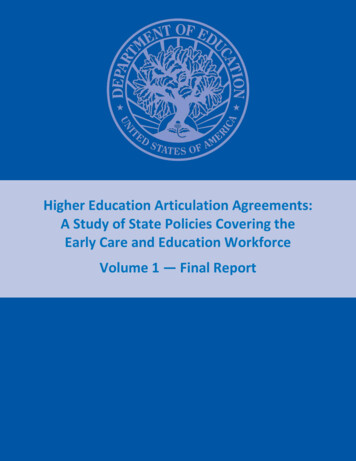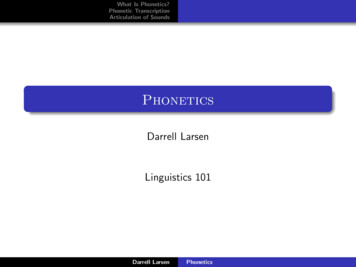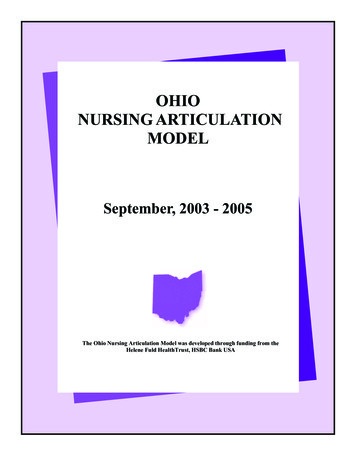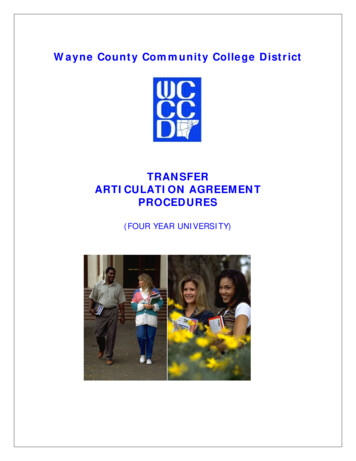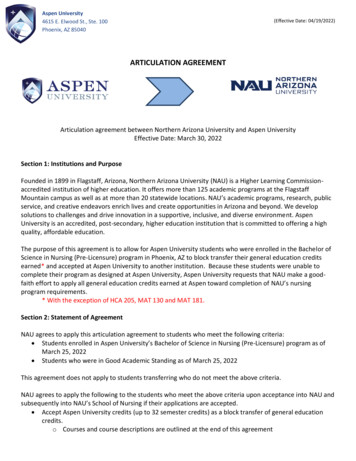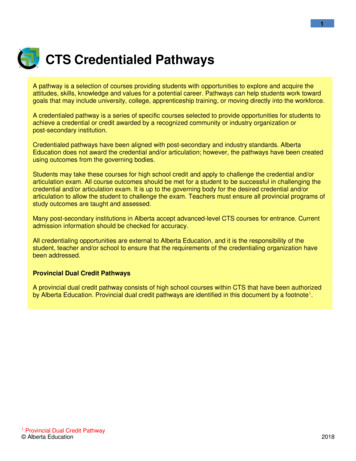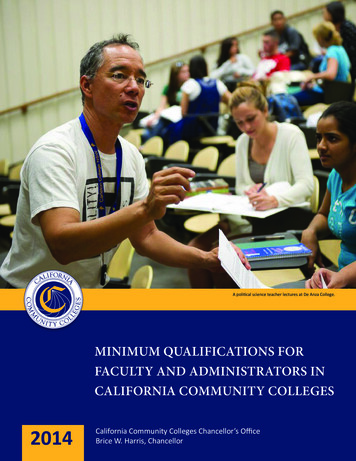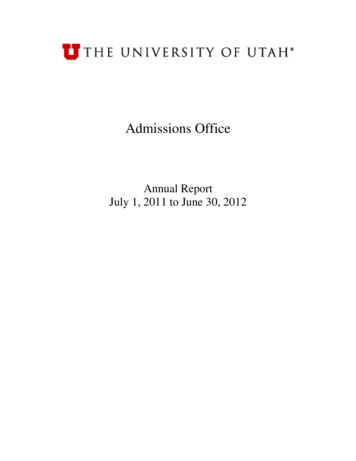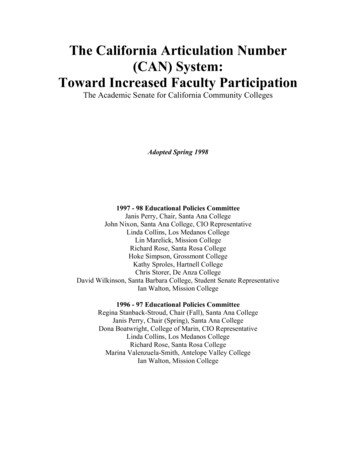
Transcription
The California Articulation Number(CAN) System:Toward Increased Faculty ParticipationThe Academic Senate for California Community CollegesAdopted Spring 19981997 - 98 Educational Policies CommitteeJanis Perry, Chair, Santa Ana CollegeJohn Nixon, Santa Ana College, CIO RepresentativeLinda Collins, Los Medanos CollegeLin Marelick, Mission CollegeRichard Rose, Santa Rosa CollegeHoke Simpson, Grossmont CollegeKathy Sproles, Hartnell CollegeChris Storer, De Anza CollegeDavid Wilkinson, Santa Barbara College, Student Senate RepresentativeIan Walton, Mission College1996 - 97 Educational Policies CommitteeRegina Stanback-Stroud, Chair (Fall), Santa Ana CollegeJanis Perry, Chair (Spring), Santa Ana CollegeDona Boatwright, College of Marin, CIO RepresentativeLinda Collins, Los Medanos CollegeRichard Rose, Santa Rosa CollegeMarina Valenzuela-Smith, Antelope Valley CollegeIan Walton, Mission College
TABLE OF CONTENTSAbstract .1Introduction.2Background of CAN .3Origin of CAN .3The CAN System .5Criteria to Quality a Course for CAN .6The CAN Process.6CAN Coordinating Council .7Faculty Participation in CAN.7Role of Articulation Officer.8CAN Funding and Evaluation.9Recommendations to Local Senates .10Summary .10Bibliography .12Appendices.13
ABSTRACTThis paper responds to plenary session resolutions directing the Academic Senate ExecutiveCommittee to prepare a background paper regarding faculty participation, evaluation and fundingof the California Articulation Number (CAN) system.The paper explores the background and purpose of CAN, examines the CAN-ing process,describes the criteria to qualify courses, discusses faculty participation and identifies systemwideissues in the evaluation and funding of the project.Local senates should view the CAN-ing process as part of the local curriculum review / approvalprocess and assure that there is faculty participation and oversight. This paper will assist localsenates to understand the CAN process and make specific recommendations to ensure facultyand local senate involvement.1
INTRODUCTIONThe purpose of this paper is to respond to Fall 1994 Plenary Session resolutions (4.4 and 4.5)directing the Educational Policies Committee to prepare a background paper andrecommendations regarding faculty participation, evaluation and funding of CAN and assist localsenates to better understand the CAN process. The resolutions are as follows:F94 4.4CAN Evaluation and Senate ParticipationTherefore be it resolved that the Academic Senate for California Community Collegesseek to broaden faculty participation on the CAN Coordinating Council, andBe it further resolved that the Academic Senate for California Community Collegesparticipate in an evaluation of CAN, andBe it finally resolved that the Academic Senate for California Community Colleges urgethe CAN Coordinating Council and the Chancellor to seek funding sources other than theIntersegmental Joint Faculty Projects fund.F94 4.5Funding of CAN (California Articulation Number)SystemTherefore be it resolved that the Academic Senate for California Community Collegesrecommend to the Chancellor that any further fiscal contribution by the CCC to the CANproject be predicated on the conduct of a formal evaluation which relies primarily on theinput from counseling faculty and students, andBe it further resolved that the Academic Senate for California Community Collegesrecommend to the Board of Governors that the CAN System Coordinating Council beexpanded to include broader community college faculty representation appointed solelyby the Academic Senate for California Community Colleges.The Academic Senate for California Community Colleges has consistently supported eliminatingbarriers to transfer and recommended the use of an alternate course number system as an option,as long as it includes the elements of academic integrity, academic freedom, appropriateprocesses and resources for articulation.In its paper Toward A Common Course Numbering System (Fall 1995), the Academic Senate forCalifornia Community Colleges recognized that the California Articulation Number System(CAN) is a key element in the discussion of intersegmental and intrasegmental articulation. Thispaper concurred with the 1985 California Postsecondary Education Commission (CPEC) studythat a uniform course numbering system is not feasible in light of the number of colleges, localgovernance responsibilities, wide range of curriculum development processes and astronomicalcost. Therefore an alternate course numbering system should serve as an expanded numberingsystem, not replace the institution's number and titles, and be a cross reference on a statewidematrix.2
BACKGROUND OF CANThere are many factors which affect the successful transfer of a student and influence the roleand responsibility of colleges and their collective faculty. One major consideration in thestudent's ability to transfer, either intra-segmentally or inter-segmentally, is the college havingthe necessary course-to-course articulation.California Community College students need to have quality course-to-course articulation and acourse numbering system which provides accurate academic preparation information.Community college students must know which courses to complete at their home campus tomeet specific degree requirements at the receiving institutions. A lack of an articulated,comprehensive, statewide, alternate or expanded numbering system results in transfer studentslosing time and credit in fulfilling degree requirements. One solution to this problem is the useof an expanded CAN system.Currently, the CAN system reports that 100 California Community Colleges (CCC), 19California State Universities (CSU), one University of California (UC), and four privateuniversities and colleges are participating in qualifying courses for CAN. There are 7,186community college courses that have been CAN approved. This number continues to increaseeach year.ORIGIN OF CANHistorically, there has been much concern over the complexities facing transfer students, barriersto transfer from community colleges to CSU and UC, - particularly for disadvantaged andunderrepresented students--as well as the stagnant rate of overall transfer. As an approach toassist in overcoming these barriers, CAN began as a voluntary pilot project in 1982. The projectinvolved 12 community colleges and five four-year institutions that were updating theirarticulation agreements and identifying the most commonly transferred courses in 27disciplines1.The CAN pilot goal was to provide a statewide articulation system and simplify the confusingmultiplicity of course numbering systems facing transfer students without requiring theseinstitutions to abandon their own course numbers and titles. As a result, in 1983, the CANproject started statewide on a voluntary basis under a flexible, mutually acceptable set ofprocedures for institutional participation. During this phase the project was operated withoutstate funding.1A Guide for California Articulation Numbering System, California Postsecondary EducationCommission, 1992.3
In addition in 1983, Senate Bill 851 directed the California Postsecondary EducationCommission (CPEC) to develop a plan for a course numbering system to be used by publicpostsecondary educational institutions. The bill reflected a concern about barriers to transfer,primarily for students who were historically underrepresented in higher education. Latercodified, Education Code, Chapter 565, directed that the course numbering system be designedto do the following: Promote the transfer of community college students to four - year postsecondaryinstitutions by simplifying the identification of transferable courses and specificdisciplines and programs to which those courses are transferable.Promote the development of a common method of course identification withineach segment of public postsecondary education where there is a clear need forsuch a common method.Help identify courses with comparable content, so that certain competencies canbe expected upon completion of such courses.There were several issues implied in the statute mandating the development of a plan2:1.2.3.4.5.The extent to which a common course-numbering system in California wouldreduce problems of community college transfer students in meeting baccalaureatedegree requirements in an efficient and timely fashion;The feasibility of implementing or adapting a statewide common coursenumbering system like that in place in Florida;The cost of implementing such a system, including developmental andmaintenance costs and its likely cost effectiveness;The alternative to a uniform, statewide course numbering system, its feasibility,and cost; andThe ability of the California Community Colleges, the University of California,and the California State Universities to implement alternative systems and theirpotential support of these options.In response to SB815, CPEC conducted a study that addressed the usefulness, feasibility, andcost of implementing a common course numbering system. CPEC conducted a nationwide studyof course numbering systems. The research indicated that only Florida and Puerto Rico hadcommon course numbering systems. The two-year colleges in Puerto Rico are part of theuniversity system, thus leaving Florida as the only state with two or more segments of publichigher education to have developed a common course numbering system.2Common Course – Numbering System, A Report to the Legislature in Response to Senate Bill 851, pg. 2,CPEC 1983.4
The CPEC study3 completed in December 1984 concluded that: “A systematic approach to numbering baccalaureate level courses offered byCalifornia's various segments and institutions of higher education would helpstudents make choices related to transfer, plan their lower division programs, andevaluate alternative transfer opportunities.” “A uniform course numbering system like that in Florida is unnecessary inCalifornia, excessively costly and bureaucratic, and probably unworkable becauseof the size and complexity of California higher education. Furthermore, such auniform system appears to make unduly simplistic assumptions about thecomparability or equivalency of courses offered by different institutions and givescommunity college students and counselors a false sense of security aboutequivalency if they are not familiar with the special conditions and limitationsimposed by some institutions on transfer courses with common numbers.”The conclusions of CPEC included a more systematic approach to numbering baccalaureate levelcourses and the expansion of CAN. The conclusions also argued that course equivalency guidesand matrices of equivalent courses would be of limited value in California because of the largenumber of programs and institutions involved in the transfer function in California.In January 1985,CPEC made a recommendation to the legislature and Governor to fund theimplementation of the CAN system. In partnership with the faculty in the UC and CSU, theAcademic Senate concurred with that recommendation and urged the systems to work to adoptCAN numbers for all undergraduate courses offered generally across campuses in each segment.Thus, the CAN system officially started July 1985, with the three systems of public highereducation sharing the funding. In November 1990, UC withdrew its funding support due tobudget constraints, subsequently leaving CAN funding to be shared by the CCC and CSU. ACAN Coordinating Committee, comprised of representatives from CCC, CSU, UC, andAssociation of Independent California Colleges and Universities (AAICU), provides oversightand direction.THE CAN SYSTEMThe CAN System is a cross reference course identification system for lower division,transferable major preparation courses. The CAN system is based on course articulation -courses considered to be comparable, but not necessarily identical, and acceptable “in lieu of”3A Guide for the California Articulation Numbering System. California Postsecondary EducationCommission, 19955
each other. The CAN system allows each campus to retain its own course number, prefix, andtitle. CAN course numbers are listed next to the campus course number and prefix in localcollege catalogs and other publications.Criteria to Qualify a Course for CANThe criterion for courses to qualify to use a CAN prefix is the same for both community collegesand four-year institutions. Course descriptions were developed by intersegmental facultycommittees. The descriptions are guidelines for discipline faculty to determine that acomparable course is offered on their campus in order to identify it for the CAN system.The CAN system is based on written faculty approved articulation of courses between campuses.To qualify a course the following criterion must be met: Negotiate written, faculty approved articulation agreements on each course withfour California public four-year institutions. (See Appendix A)4The CAN ProcessThe basic premise of the CAN System is that identically numbered CAN courses are acceptable“in lieu of” each other. Campuses with one or more courses that have met the criterion, andwhose officials have signed the “Statement of Commitment,” agree to accept the identicallynumbered courses and use them in the same way their own CAN qualified courses are used. TheCAN system eliminates the necessity for each campus to negotiate articulation agreements withevery other campus.5Each campus retains its own course number, prefix, and title. The CAN designation (e.g., CANCHEM 2) is simply added to the course listing in the class schedule, catalogs, and transcripts toassure it is readily identifiable to anyone seeking the information. Students at the participatingcampus have the certainty that a CAN designated course on their campus will be accepted in lieuof an identically designated CAN course at any other participating campus in the state.Each course included in the system has been assigned a number and discipline prefix, (e.g.,CAN ENGL 2). Semester courses carry EVEN numbers, and quarter unit courses are assignedODD numbers, (e.g., CAN ENGL 1). When a sequence of courses within a discipline is the sumof the content of two or more courses, it is assigned a letter designation, (e.g., CAN ENGL SEQA).45A Guide for California Articulation Number System. CPEC Commission, 1995, pg. 7A Guide for California Articulation Number System. CPEC Commission, 1995, pg. 96
CAN Coordinating CouncilThe CAN system is overseen by the CAN Coordinating Council which meets two or three timesa year to monitor the implementation of the number system statewide, formulate policy, andestablish goals. The council serves as a forum for the exchange of information, debate anddiscussion of major issues related to the CAN system. Representatives from the system officesof the three segments, the statewide academic senates, and articulation officers from the CCC,CSU, and the independent colleges and universities serve on the coordinating council.Upon review, the current CAN Coordinating Council structure does not reflect the primary roleof faculty over the curriculum. It is the faculty who are responsible for validating the meeting ofeducational requirements and who possess the academic expertise to determine the educationalstandards of courses, programs, and educational models. Therefore, the faculty should be theprimary contributor to the monitoring, implementation, policy formulation, and establishing ofgoals for the CAN system.Faculty Participation In CANThe Academic Senate paper, The Curriculum Committee: Role, Structure, Duties, and Standardsof Good Practice, explicitly states “the design of curricula needed to carry out instruction is theprimary role of the faculty and the major area of professional expertise. The faculty maintain a“collective oversight” of the curriculum processes through the Academic Senate in its role ofrecommending policies and procedures in the area of curriculum, and by the curriculumcommittee, as the vehicle by which the academic senate assures that those policies andprocedures are implemented and that quality, effective course and programs are recommendedfor approval.”6Most colleges have placed the CAN-ing process as part of the articulation function anddistinguished separately from the curriculum process. However, the CAN-ing of a course ispredicated on faculty-to-faculty dialogue and articulation agreements.The actual process of developing and reviewing curriculum and coursework to determine coursecomparability between institutions rests with the faculty. Faculty in each discipline areresponsible for the actual review of course content, the identification of comparable courses, andthe authorization of acceptance of specific courses for transferring students. Once this review,identification, and formal written acceptance process has occurred, a course (or courses) is saidto have been "articulated". Implicit in the articulation process is involvement, communication,and cooperation between the respective faculties who mutually develop curriculum and establishrequirements and standards for articulated courses.76The Curriculum Committee: Role, Structure, Duties and Standards of Good Practice, Academic Senate forCalifornia Community Colleges, 19967Handbook of California Articulation Policies and Procedures, 19957
Those agreements become part of the curriculum processes of the local college and therefore aresubjected to local Academic Senate oversight as an academic and professional matter.ROLE OF THE ARTICULATION OFFICERThe process of faculty review leading to the articulation of courses between institutions iscoordinated and facilitated by the Articulation Officer on each campus. Specifically, theArticulation Officer: Initiates faculty approved articulation agreements between institutions of highereducation. Serves as a consultant to faculty and academic units, providing needed materialsand information about course articulation proposals and acceptance. Serves as an advocate for the faculty and campus academic programs. Serves as an advocate for the other articulating institution. Serves as a moderator and mediator of problems or disagreements between thefaculties of the home campus and the articulating institutions. Serves on appropriate campus committees. Monitors each stage of the articulation process and follows up withdepartments/faculty for timely responses and decisions.8The articulation function in the CAN-ing processes is labor intensive, time consuming, and lessunderstood as it relates to the curriculum approval functions on local campuses. At the Fall 1992Plenary Session, the faculty passed a Resolution (4.1) that local academic senates support thearticulation officer function. The resolution reads:F924.1Articulation Officers in Curriculum CommitteesBe it resolved that the Academic Senate for California Community Colleges encouragelocal senates to ensure that their articulation officer serve as a resource to the campuscurriculum committee, andBe it further resolved that the Academic Senate for California Community Colleges urgelocal senates to ensure that support of an articulation officer be a campus priority,including the support of the articulation function and clerical assistance.The Academic Senate Educational Policy Committee in its recent survey (see Appendix B)found: forty-seven percent of the colleges reporting indicated that less than .5 FTE ofstaff time is spent on articulation. ninety-two percent of the colleges reporting indicated that there is not enoughrelease time to adequately perform the articulation function.8Handbook of California Articulation Policies and Procedures, 1995, pg. 2.8
eighty-two percent of the colleges reported that the articulation officer is a facultymember (usually doing articulation as part of their assignment. Ten percentreported that their officer was an administrator (as part of his or her assignment).Eight percent reported having classified staff serve as articulation officers.ninety-five percent of the colleges reported that the articulation officer servedeither as a voting member (faculty) or non voting member(classified/administrator) of their curriculum committee.The responses to a recent survey (Spring 1997) indicated a continued need for staffing resourcesto support the articulation function on most campuses. Local senates need to take a proactiverole to ensure this becomes a college priority.CAN FUNDING AND EVALUATIONThe funding level for the CAN system has not increased since its inception in 1985. The projectsuffered a loss of 70,000 in funding when UC withdrew its support in 1990-91. Subsequently,CSU and CCC were forced to look to other funding sources to cover the costs of operating thesystem. The California Community Colleges Chancellor’s Office used 50,000 of theIntersegmental Joint Faculty Projects Fund which was originally intended to be used forintersegmental faculty-to-faculty projects.Conversations with the CAN system office and the Chancellor’s Office staff revealed that theproject has not undergone any formal evaluation of the efficacy and efficiency of its services.The CAN project has only recently received authorization and funding to conduct a programevaluation.In response to Academic Senate resolutions (F94 4.4 and 4.5) calling for more facultyparticipation and evaluation of CAN, the Academic Senate Executive Committee has approvedrecommending to the Chancellor's Office that the following items be included in any formalevaluation (see Appendix C) of the CAN project. The CAN grant proposal included thefollowing criteria:1.Evaluate structural and functional characteristics of CAN that create and maintainbarriers to the CAN-ing of courses.2.Evaluate the structures and functions of CAN that effect the dissemination andacquisition of information regarding the CAN processes. To what extent doesCAN actually solicit or encourage participation by the four- year institutions?3.Evaluate CAN's ability to make successful CAN processes available to interestedinstitutions in order to facilitate the “CAN-ing” of courses.4.Evaluate the level of active faculty -to- faculty dialogue supported by the CANprocesses.9
5.Evaluate the role of the community college faculty in the governance of CAN.6.Evaluate to what extent the existing structure or a changed structure of CANcould and would provide for intra-segmental community college transfer.7.Evaluate the role of the Articulation Officer in the CAN processes.8.Evaluate how the CAN process recognizes or ensures the final CAN agreement isa result of articulation agreements that include appropriate faculty signatures.These items were presented to the Chancellor's office in Spring 1997 with the recommendationthat they become part of the established criteria in the grant proposal to fund any CANevaluation.RECOMMENDATIONS TO LOCAL SENATESIn researching the background information on the CAN System and evaluating the results of theaccompanying survey of local college articulation practices (see Appendix C), the AcademicSenate for California Community Colleges would make the following recommendations to localsenates:1.Local Senates recognize the CAN process as part of the local curriculumreview/approval process.2.Local Senates must ensure that the signatures of discipline faculty are on therequest forms (e.g., Statements of Commitment) when submitting courses forCAN approval. This documentation should be provided by the colleges.3.As a standard of practice, the articulation function on the campus should beassumed by a faculty member with the knowledge and expertise of thecurriculum.4.Local Senates should evaluate the amount of time needed for articulation withinthe college, particularly that needed to develop articulation agreements and CANing of courses, to ensure that students can identify transferable courses requiredfor access.5.Local Senates should ensure that the articulation officer participates in thecurriculum approval process by being a resource to or serving on the curriculumcommittee.10
SUMMARYIn summary, this paper furthers the recognition that CAN is critical to any dialogue aboutintersegmental or intrasegmental articulation. The process of CAN-ing a course is part of thearticulation function, however on local campuses this process is often mistakenly distinguishedas separate from the curriculum process, and should not be so.Further, faculty participation in the CAN-ing process is essential. The actual process ofdeveloping and reviewing curriculum and coursework to determine course comparabilitybetween institutions resides with the discipline faculty. The process is predicated on faculty-tofaculty dialogue resulting in articulation. This articulation is facilitated by the collegeArticulation Officer who may or may not be a faculty member. This articulation function is laborintensive, time consuming, and less understood within the curriculum approval function on localcampuses than it should be.Finally, this paper demonstrates that local senates have a responsibility to remain informed onthe CAN-ing process, as it relates to articulation and curriculum approval/review. Local senatesneed to ensure that when the college submits courses for CAN approval that there is evidence offaculty signatures on the course to course articulation agreements.11
BIBLIOGRAPHY1.California Postsecondary Education Commission, “A Guide for California ArticulationNumbering System,” 1992.2.California Postsecondary Education Commission, “Common Course - Numbering System,A Report to the Legislature in Response to Senate Bill 851,” 1998.3.California Postsecondary Education Commission, “A Guide for the CaliforniaArticulation Numbering System,” 1995.4.Academic Senate for California Community Colleges, “The Curriculum Committee:Role, Structure, Duties and Standards of Good Practice,” 1996.5.California Community College, “Handbook of California Articulation Policies andProcedures,” 1995.12
APPENDIX A(A Guide for the California Articulation Number System. Revised 1995)What are the Criteria to Qualify A Coursefor the California Articulation Number System?Accredited public or private colleges anduniversities in California offering associate degrees,baccalaureate-level transfer courses, or baccalaureatedegrees may qualify courses to use CaliforniaArticulation Numbers and participate in the System.NEGOCIATE WRITTEN, FACULTY APPROVEDARTICULATION AGREEMENTS ON EACHCOURSE WITH 4 CALIFORNIA PUBLIC FOURYEAR INSTITUTIONS.Figures 1 and 2 illustrate a possible set ofarticulation agreements for a campus to qualify acourse. The double-headed arrow symbol indicatesbilateral, verified articulation agreements are ineffect.The California Articulation Number System isbased on written, faculty-approved articulation ofcourses between campuses. To qualify a course touse a California Articulation Number, the followingcriteria must be met for each course:FIGURE 1. General Chemistry for Science Majors - 2 yr. campusCHEM 1A at Mt. San Antonioqualifies to use CAN CHEM 2CHEM 1A atMt. San AntonioCHEM 120ACSUFUCHEM 111ACSULBCHEM 200SDSUCHEM 1AUCBFIGURE 2. Introduction to Macroeconomics - 4 yr. campusECON 202 at CSUSBqualifies to use CAN ECON 2ECON 202 atCSUSBECON 2UCSCECON 20CSUFUECON 1ACSUS13ECON 2UCR
APPENDIX BEDUCATIONAL POLICIES COMMITTEECalifornia Numbering System SurveyFebruary 19971. What structural and functional characteristics of CAN create and maintain barriers tothe creation or “CAN-ing” of courses on your campus?-University of California system does not participate.Time it takes to get articulation agreements authorized by four-year institutions.Getting articulation updates from four-year institutions when curriculum changes are made.CAN office - functions only as “middle man.”Difficult to discuss directly with four-year institutions.Number of colleges needed to have a course “CAN” qualified.Faculty may not wish to modify curriculum to qualify CAN courses.Difficult for small community colleges to get four-year colleges to authorize.Course-to-course vs. sequence verification can be a problem because of quarter vs.semester course.2. To what extent does CAN solicit or encourage participation by the four-yearinstitutions?- Local community college level--(unknown). Limited interaction between faculty.- System level - CAN office encourages and solici
Ian Walton, Mission College 1996 - 97 Educational Policies Committee Regina Stanback-Stroud, Chair (Fall), Santa Ana College Janis Perry, Chair (Spring), Santa Ana College Dona Boatwright, College of Marin, CIO Representative Linda Collins, Los Medanos College Richard Rose, Santa Rosa College Marina Valenzuela-Smith, Antelope Valley College


